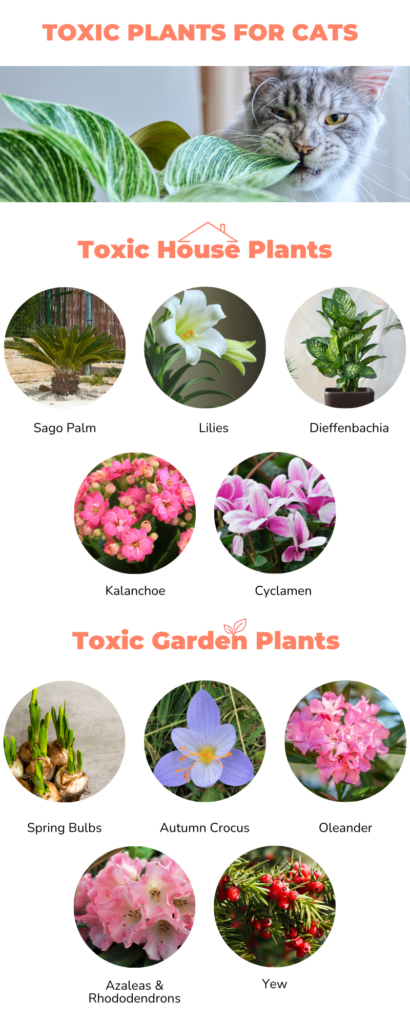It’s no secret that cats are curious creatures. Both indoor and outdoor cats wander in a completely different manner than dogs do. It’s one of our favorite characteristics about cats in general, except when it comes to toxic plants.
For cat parents with a green thumb, it’s important to familiarize yourself with the plants to avoid before choosing plants for your home or garden. Especially because the toxicity of plants can range from mild to severe, depending on the toxic component.
So while this blog is not a comprehensive list, it does cover the most common house and garden plants that are a toxic threat to our feline friends.

Toxic House Plants for Cats
- Dieffenbachia: This houseplant is so common, we listed it for dogs too. While it’s not associated with fatal symptoms, calcium oxalate crystals in the leaves cause a burning sensation to your cat’s mouth, lips and throat. While not considered deadly, it’s best to avoid this plant altogether.
- Lilies: Of all the plants out there, lilies are one of the most dangerous flowers to cats because every part of the plant is toxic – the leaves, flowers, pollen, and even the water. If your cat chews the leaves or even licks leftover water from the vase, it can trigger life-threatening kidney failure. Since the risks are so high, it’s best to be safe and avoid lilies altogether.
- Sago Palm: Sago palms may look like a tiny palm tree, but they’re extremely toxic to cats and dogs. While the entire plant is toxic, the seeds or “nuts” contain the highest concentration of toxins. Cycasin in this plant can cause liver damage or seizures in cats. Other side effects include bloody vomiting, weakness and diarrhea.
- Kalanchoe: Also known as Mother-in-law plant or Devil’s Backbone, all parts of this plant contain bufadienolides, which causes gastrointestinal upset that can trigger drooling, vomiting and diarrhea.
- Cyclamen: These perennial flowering plants, also known as Persian violet, are often kept indoors. This plant contains the toxin saponin, which is most concentrated in the roots and tubers. Small amounts on saponin can cause drooling, vomiting and diarrhea. In contrast, large quantities of saponin can cause trigger an abnormal heart rate, seizures, and potentially death.
Toxic Garden Plants for Cats
- Autumn Crocus: Autumn Crocuses is a common garden flower that beautifully blooms in the fall but is dangerous to cats and dogs. If eaten, the alkaloid colchicine is highly toxic and can cause severe digestive upset, breathing difficulties, seizures, kidney and liver damage, and potentially death.
- Azaleas & Rhododendrons: There are a wide range of species in this well-known family of plants, and the degree of toxicity varies from moderate to severe. Symptoms of azalea or rhododendron poisoning include gastrointestinal upset, heart arrhythmias, tremors, seizures, and potentially death. If you have this species in your yard, prevent contact with your cat and avoid bringing these inside as well.
- Oleander: This flowering shrub is a common outdoor plant in warm climates, and one of the deadliest. Oleander contains glycosides that interfere with the heart rhythm and can cause tremors, seizures and fatal heart abnormalities.
- Spring Bulbs (Tulips & Hyacinths, Daffodils, Amaryllis, & Irises): Ingestion of these spring bulbs contain high concentrations of toxins that cause vomiting, drooling and in severe cases, breathing and heart problems.
- Yew: These evergreens are common hedges and found in holiday wreaths and decorations. These waxy needles and bright red berries can cause gastrointestinal upset, tremors, breathing difficulties and in the most severe cases, cardiac failure.
If you remember only a few plants from this list, remember to avoid Lilies, Sago Palms and Oleander. This is by no means a complete list of all the plants that are toxic to cats. For a comprehensive list, visit ASPCA’s Animal Poison Control website.
Symptoms of Plant Poisoning in Cats
Symptoms vary depending on the amount and type of plant ingested, but the symptoms below are a sign for alarm that your cat may have been exposed to a toxic plant.
- Vomiting and diarrhea (which may be mild to severe, and may or may not contain blood).
- Drooling
- Oral pain or difficulty swallowing
- Loss of appetite
- Seizures or tremors
- Itchiness or irritation
- Trouble breathing
- Sudden limping or loss of motor function in one or more limbs
- Irregular heartbeat (cardiac arrhythmias) indicated by weakness, staggering, shaking and mobility issues
- Excessive water drinking or urination
What Should I Do If My Cat Has Ingested a Toxic Plant?
- Contact your veterinarian or closest 24-hour emergency vet. Symptoms may be delayed, but timing and early intervention improves treatment success. Note: The ReadiVet team does not provide emergency services outside of normal business hours. If you your pet may be experiencing a life-threatening emergency, please contact an emergency care facility near you.
- If you can’t reach a veterinarian right away, call the ASPCA’s Animal Poison Control Hotline (888-426-4435) or the Pet Poison Helpline (855-764-7661). They’re available 24/7 to evaluate exposure and consult you on the right course of action.
- Identify the plant in question with a photo, small clipping or even remnants from vomit or stool. Different plants require different treatments, so this is important information for your vet to know.
- Do not try to induce vomiting unless instructed to do so by your veterinarian or a pet poison control expert.
Don’t be afraid to embrace greenery inside and outside of the home, especially during spring and summer seasons. As a rule of (green) thumb to protect your curious cats, always run a quick Google search to double-check any greenery you bring home is safe for cats.
Spring and summer are full of sun and outdoor adventures, but it also comes with unexpected hazards for our furry friends. That’s why we offer mobile veterinary care for wellness exams, seasonal allergy shots, vaccinations and preventative medications.
Contact us today to schedule a wellness exam in the comfort of your home.




